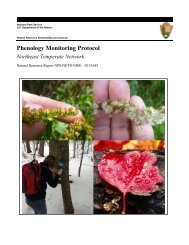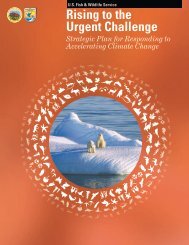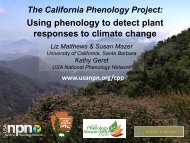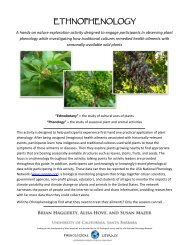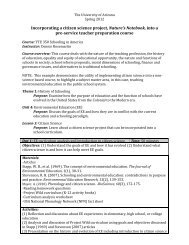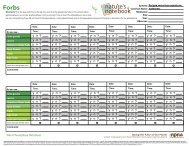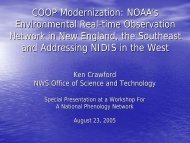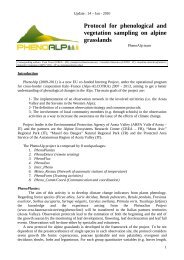The Phenology Handbook - USA National Phenology Network
The Phenology Handbook - USA National Phenology Network
The Phenology Handbook - USA National Phenology Network
Create successful ePaper yourself
Turn your PDF publications into a flip-book with our unique Google optimized e-Paper software.
Acknowledgments<br />
Since the Spring of 2007 it has been our great pleasure to work with a wide variety of students, educators, scientists,<br />
and nature enthusiasts while developing the <strong>Phenology</strong> Stewardship Program at the University of California,<br />
Santa Barbara. We would like to express our gratitude to those who have contributed (and who are currently contributing)<br />
time and energy for field observations, classroom implementation, and community outreach. We thank<br />
the <strong>Phenology</strong> Stewards (UCSB undergraduates) who have helped to collect plant and avian phenological data at<br />
UCSB’s Coal Oil Point Natural Reserve and to develop the methodologies and protocols that are presented in this<br />
handbook. Special thanks to the <strong>Phenology</strong> Stewardship graphic design team who helped develop this handbook.<br />
We also thank Scott Bull, the UCSB Coastal Fund, and the students of UCSB for providing funding for the development<br />
of the <strong>Phenology</strong> Stewardship Program at UCSB.<br />
We would like to thank those in the Santa Barbara region who are implementing phenology education and engaging<br />
students to participate in Project Budburst and the <strong>USA</strong> <strong>National</strong> <strong>Phenology</strong> <strong>Network</strong>, including:<br />
• Dr. Jennifer Thorsch and UCSB’s Cheadle Center for Biodiversity and Ecological Restoration (CCBER), as<br />
well as the teachers associated with CCBER’s “Kids In Nature” environmental education program;<br />
• the “teachers in training” in the Teacher Education Program at UCSB’s Gevirtz School of Graduate Education<br />
who work in K-12 schools throughout Santa Barbara;<br />
• docents at natural reserves and botanic gardens, including Coal Oil Point, Sedgwick, Arroyo Hondo, Rancho<br />
Santa Ana, Carpenteria Salt Marsh, Santa Barbara Botanic Garden, Lotusland Botanic Garden; and<br />
• Kate Eschelbach, education & outreach specialist with the Ventura office of the US Fish & Wildlife Service,<br />
who has been instrumental in expanding our phenology science & education efforts in Southern California.<br />
We would also like to express our gratitude to the consortium of scientists and educators associated with the <strong>USA</strong><br />
<strong>National</strong> <strong>Phenology</strong> <strong>Network</strong>, and especially to our colleagues in the NPN’s Education, Citizen Science, and Outreach<br />
working group. With operational support from the University Corporation for Atmospheric Reserach and<br />
with funding from the U.S. Bureau of Land Management, the <strong>National</strong> Science Foundation, ESRI, and the <strong>National</strong><br />
Fish and Wildlife Foundation, the ECSO working group launched Project Budburst in the Spring of 2007.<br />
This <strong>Phenology</strong> <strong>Handbook</strong> is a work in progress, and will be updated continually through the summer and fall of<br />
2009. We plan to increase the scope of the handbook by including a chapter that describes methods for using the<br />
herbarium to study historical phenology, as well as more species descriptions in the <strong>Phenology</strong> Field Guide.<br />
•<br />
Brian P Haggerty, M.S.<br />
Susan J Mazer, PhD<br />
Santa Barbara, California<br />
Summer, 2009



